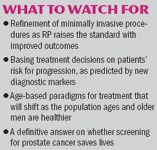Article
Changes are imminent in treatment of prostate Ca
Ongoing research on a variety of fronts has yet to make a revolutionary impact on the management of localized prostate cancer, but changes are likely on the horizon, according to Richard D. Williams, MD.
Ongoing research on a variety of fronts has yet to make a revolutionary impact on the management of localized prostate cancer, but changes are likely on the horizon, according to Richard D. Williams, MD.

Currently, minimally invasive surgery continues to take center stage, and the minimally invasive techniques of radiofrequency ablation and high-intensity focused ultrasound are up and coming. Both have been shown to be safe and to have benefits. However, none of those procedures has been compared against radical prostatectomy or radiation therapy in a prospective, randomized, parallel-design trial, so they have not been conclusively demonstrated to be as good or better with respect to such outcomes as potency, continence, and cure rates.

"Which of the minimally invasive methods proves itself to be best remains to be determined."
Noteworthy AUA reportsLooking to information that will be presented at the AUA annual meeting, Dr. Williams identified several studies of particular interest. Canadian researchers are providing evidence that the increase in higher-grade tumors among men randomized to finasteride (Proscar) in the Prostate Cancer Prevention Trial may be a consequence of the drug's effect on reducing prostate volume. Using their own institutional dataset, they analyzed risk factors for higher-grade tumors diagnosed by biopsy and RP and found that while higher prostate volume predicted low-grade disease, it was not predictive of true histologic grade.
"These results suggest the finding of more high-grade cancers on biopsy in smaller prostates after finasteride treatment is a sampling artifact," Dr. Williams said.
He also cited a study in which investigators measured serum testosterone levels in a series of consecutive men with elevated PSA or abnormal DRE presenting for prostate biopsy. The results showed a high proportion of the study population was hypogonadal, and when compared with their eugonadal counterparts, the hypogonadal men had comparable PSA parameters but an increased risk of prostate cancer.
"This study raises the issue of whether testosterone measurement should be incorporated as part of prostate cancer screening and suggests that a low serum testosterone should raise the index of suspicion for prostate cancer in men even with a low PSA," Dr. Williams said.
Newsletter
Stay current with the latest urology news and practice-changing insights — sign up now for the essential updates every urologist needs.





